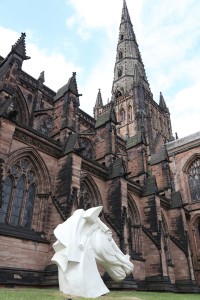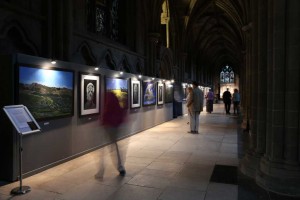by Arleen V. Trickett (Lay Chaplain at Lichfield Cathedral)
Arriving at about 8.30 on a sunlit, slightly misty morning in August my first thought on seeing the sculptures outside the west front of the Cathedral was ‘wow, the wooden horse of Troy has relocated – how good is that!’ On closer inspection, unlike the original, the horse bowed its head in deference to its sacred surroundings and proved to be made of corten steel the weathering steel from which the Angel of the North is made. It exuded essence and spirit of the horse. Directly opposite was a young colt kicking up his heels for the sheer joy of just being alive, (I almost wanted to do the same!)

Inside the nave more sculptures, birds, antelopes, bulls all shouting the message that life is for living including a corten steel loudspeaker horn to reinforce and amplify the message further.

In the Choir aisle the paintings spoke of life and our relationships throughout differing times from the Paleolithic to the modern; yet again all are linked.
The sculpted heads in the vestibule are reminiscent of the Moai at Rano Ravaku on Easter Island staring out over the oceans across the centuries a link to a different past on a different continent. Outside on the south side the two large white horses heads again suggest links with the Parthenon and ancient Greece and our Viking past with Odin’s horse – many cultures, many cultures, many links, one earth.
The two paintings in the North transept summed up everything I felt the artist was wanting to convey. The landscape spoke of our place in the story of life and the changes we make, the constant morphing that goes on and that we are unaware of. The painting of the horse by the North Choir Aisle gate managed to be at one and the same time a portrait and a technical drawing and being both aspirational and didactic had so many reference points: it showed very accurately the underlying mechanisms and basic structures of life, the precision of the living bones, the muscles and the skin; the life force; the potential; the arms; the trust; the willingness to try to accommodate human demands and stupidity throughout history from ploughing to warfare, the strength and the fragility and physical inability to overcome insuperable odds (we all grow old and die) and yet the footprint on the sands of time remains and has respect and value – Book of Job Ch:30 ‘and what of the horse’.

I felt that the message Peter was giving us was that the timeline of history connects all things, we are each made of the same dust to which ultimately we each return and the basic fragility of life which undercuts us all precisely, what makes it valuable (and is probably the reason why the mythological gods on mount Olympus were so jealous of us humans!).
As a lay chaplain I walk the Cathedral floor and listen to people and they talk to me. Some people said they found the paintings disturbing and upsetting – and I would try to explain and reply ok that’s fine – yes because they speak of the brevity, sadness and pain of life. There is pain in the eyes as we view our place in the cosmos but with the reduction to the bone there is the marvel and the beauty of symmetry, the celebration of the joy of life and the hope that lives in us all. Although man is very small when placed against the stars we are by no means insignificant because of our capacity for damage as well as good. It behoves us to take care of what we are and what we have.
